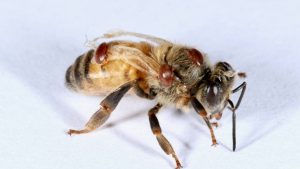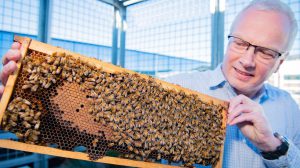Has the destructive varroa been building ‘home-grown’ pesticide resistance in NZ?

Varroa mites are responsible for the loss of tens of thousands of hives in New Zealand each year, killing countless bees like this one. Photo / Supplied
A destructive mite plaguing our beekeeping industry may have been building up home-grown resistance to a widely used chemical pesticide, a new study suggests.
Flumethrin has long been a key tool for controlling varroa, but when researchers recently assessed its mite-killing performance at one apiary, they found concentrations of it needed to be 13 times higher than two decades ago.
They say the findings, just released ahead of peer review, warrant further investigation to see if miticide resistance is a wider, hidden problem for the $5 billion industry.
Since being first detected back in 2000, the varroa destructor mite has become the sector’s biggest headache, each year accounting for nearly half of colony losses and costing more than $1 million in mitigation efforts and lost honey production.
The new study, led by PhD student Rose McGruddy and co-authored by Lester, focused on two key chemical pesticides used for varroa control.
They were flumethrin and amitraz – estimated to be used by 78 and 85 per cent of commercial beekeepers respectively.
Typically, they applied one product in early spring, and another in late summer or early autumn.

“Mite resistance to flumethrin may help explain why the mite problem is getting worse,” Victoria University ecologist Professor Phil Lester says. Photo / Supplied
“We’ve heard differing reports of the effectiveness of chemical pesticides, especially flumethrin,” Lester said.
“The nationwide survey and Rose’s data suggest most beekeepers are satisfied with it.
“But there are others who think this product is much less effective than it used to be – some even stating it has failed to control varroa entirely.”
Unlike in the past, some beekeepers were now using more than two applications of it, he said.
In the study, the researchers drew on years of survey data, along with their own laboratory tests of pesticides.
“The key result was that we found that the concentration of flumethrin needed to kill mites was 13-times higher than it was in 2005,” Lester said.
“This result indicates that mites appear to have and are developing resistance to this chemical.”
There was no evidence of any resistance to amitraz, which is another key pesticide for mite control, as it appeared to be effective, he said.
The study team stressed this result didn’t mean that commercial products containing flumethrin didn’t work – and they might still be useful for mite control for many beekeepers.
“We’d also note that the mites we used for this work were from the Wellington region and we can’t be sure that selection for resistance has occurred everywhere equally,” he said.
“But the big implication is that resistance does seem to have developed. It could explain the limited success of control using flumethrin reported to us by beekeepers.
“Mite resistance to flumethrin may help explain why the mite problem is getting worse.”
While varroa resistance to the chemical had been observed around the world, the study team didn’t find any of the same genetic markers of resistance identified in overseas studies.
“The New Zealand resistance development seems to be via a different pathway for the New Zealand population of mites,” Lester said.
The study raised several questions that urgently needed answering: namely, whether such “home-grown” was occurring more widely and, if so, how.
More broadly, Lester felt new products were needed for mite control, with novel modes of action – such as new “gene-silencing” approaches his own group was researching.
“We need to carefully manage resistance, by ensuring good integrated pest management procedures, which include alternating control methods,” he said.
“New methods are desperately needed.”
The industry’s peak body, Apiculture New Zealand, also said the study’s findings needed to be interpreted with caution.
“Because there has been growing discussion that resistance to treatments may be an issue in New Zealand, this research is of interest,” it told the Herald in a statement.
“However, although these lab concentrations differ to what was detected in 2003, they remain lower than what was detected in international apiaries with resistant varroa.
“Additionally, we note that the varroa tested in this research was collected from one apiary so it may not represent all regions.”
The group said this needed to be fully tested before any conclusions could be made regarding chemical resistance.
“As outlined by the researchers and by ApiNZ and our experts, the key to varroa management is ensuring the control methods are conducted as per label and rotated between treatment groups,” it said.
“Untreated colonies die. This does not change.”
We are here to share current happenings in the bee industry. Bee Culture gathers and shares articles published by outside sources. For more information about this specific article, please visit the original publish source: Has the destructive varroa been building ‘home-grown’ pesticide resistance in NZ? – NZ Herald








